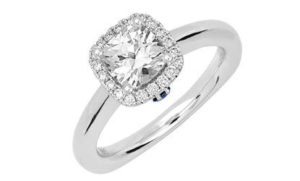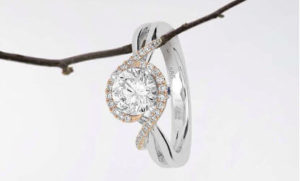LAB GROWN DIAMONDS

HISTORY
The search for manmade diamonds was triggered by the 1797 discovery that a diamond is a form of pure carbon. This was discovered by burning a diamond in a torch and analyzing the resulting gasses: 100% carbon dioxide.
Diamond is one of those materials that shifts from a solid to a gas without melting first. Most carbon found on the earth’s surface is graphite, the same as used in a pencil. However, if the carbon is under great pressure, almost a million pounds per square inch while at 1300C, it wants to be another form of carbon, called diamond. The atomic structure is quite different than graphite and very compacted. Many scientists looked at this problem with fascination. Many attempts were made to grow diamond, mostly in Europe. One would guess this desire came from knowing exactly what a material was made of but being unable to replicate it under laboratory conditions. This is what feeds the quest of scientists then and even today.
One of the earliest attempts to making diamonds in the early 1800’s was from a renowned French chemist, Dr. Henri Moissan. He theorized that diamond must somehow form deep in the earth under tremendous pressure and heat. Diamond mines are often found with concentrations of iron and nickel. Dr. Moissan theorized that if the iron and nickel were combined with carbon, brought to a liquid state, maybe diamond crystals would grow from this concentration of carbon if enough pressure was created.

Since there were no furnaces that could achieve this high temperature, he first had to invent the electric arc furnace to melt his mixture of iron, nickel, and carbon. Then, to create pressure, he poured this melt into molten lead. Since the lead was liquid at a far lower temperature, a few hundred degrees Fahrenheit versus thousands of degrees Celsius, the cooler lead would force the liquid iron and carbon mix to solidify and create pressure on the center, even if only momentarily.
Much to his amazement it worked…almost. When he broke open the solid iron core, he found tiny white crystals that easily cut glass and other hard surfaces, all the way up to corundum, the hardest know material after diamond so he declared his experiment a success, wrote up a paper and recorded his findings with the local research libraries of his time. After his early death at age 54, others attempted to replicate his diamond experiment. However, more modern means of identification were invented by then and people soon learned that it was not diamond after all. Since it didn’t seem to have the properties of any known material, they named this new white crystal after Dr Moissan, and that’s where the name Moissanite came from. Later, it was identified as silicon carbide, a very hard material but not quite diamond. Normally, a man-made material that duplicates a natural stone, is never given the “ite” designation, that is reserved for naturally occurring stones only, but the name stuck, nonetheless.
Back in the late 20’s, another young chemist-to-be in San Francisco, still in his teens, was also trying to make diamonds. His name was Carroll Chatham. He read up on what Dr. Moissan did and concluded that Moissan was on the right track, but just needed a little modification. So instead of dropping the molten iron and carbon mix into molten lead, he chose another extreme, liquid nitrogen, to force the iron and carbon mix to solidify even quicker and hopefully with more force. Luckily, young Chatham was well versed on what could happen, like spitting on a hot stove times 1000. He performed his experiment outside, on the sidewalk that ran next to his cellar window. He was very careful and out of harms way but gave little concern to the neighborhood. The results took out the windows in the house across from his and made quite an explosive sound and a huge plume of nitrogen gas surrounded his house. Nitrogen is harmless to breath but not so flying hot iron. Police came to the house, young Carroll was punished and father paid off neighbors. He never found his results, everything was gone. He never knew if he was on the right track.
However, he was forbidden to do any more experiments that caused so much disruption, so he moved on to emeralds, a gemstone not requiring such extreme conditions to make, in his opinion.
Hundreds of people have tried to make diamond over the last 200 years and many resulted in death due to the extreme nature of high pressure. Diamond is extremely handy in many machinery applications as a cutting tool or an abrasive tool. Without it some metals could not be machined, like beryllium metal. Up until WW2, everybody was happy using the low-quality natural diamond production. However, that supply was controlled by De Beers, and it became difficult to keep supplies up during the war years when so much heavy machine work was required to make armaments, be they American, German, or Russian.
 There was quite a race to make diamonds in the lab and it appears the USA won with the announcement in 1955 by General Electric and the work done by Tracy Hall and his fellow researchers. Although they take the credit and own the patents for this discovery, it has since been discovered that Russia was making diamonds before that time as well as researchers in Switzerland. However, Dr. Tracy Hall was awarded the grand prize, a $25 savings bond for his achievement! Feeling slightly underwhelmed by this generosity, that would go on to make billions of dollars for GE, Tracy Hall quit and went to work for Brigand Young University in Provo, Utah. He was forbidden to use his knowledge of making diamond by GE. His work at GE was on a simple up and down press. So he invented another type of press, the quadrangle press with four pistons. This too was taken away by GE, so he invented another type of press, the six-sided press. GE finally left him alone and let him continue his research. However, Tracy Hall never really got the acclaim he deserved. Today, his two sons run the business, still in Provo, making diamonds and diamond like materials for industrial use.
There was quite a race to make diamonds in the lab and it appears the USA won with the announcement in 1955 by General Electric and the work done by Tracy Hall and his fellow researchers. Although they take the credit and own the patents for this discovery, it has since been discovered that Russia was making diamonds before that time as well as researchers in Switzerland. However, Dr. Tracy Hall was awarded the grand prize, a $25 savings bond for his achievement! Feeling slightly underwhelmed by this generosity, that would go on to make billions of dollars for GE, Tracy Hall quit and went to work for Brigand Young University in Provo, Utah. He was forbidden to use his knowledge of making diamond by GE. His work at GE was on a simple up and down press. So he invented another type of press, the quadrangle press with four pistons. This too was taken away by GE, so he invented another type of press, the six-sided press. GE finally left him alone and let him continue his research. However, Tracy Hall never really got the acclaim he deserved. Today, his two sons run the business, still in Provo, making diamonds and diamond like materials for industrial use.
HIGH PRESSURE HIGH TEMPERATURE (HPHT) METHOD
The first basic process to grow diamonds in a laboratory is called High Pressure High Temperature, also known as the HPHT process.
Regardless of which machine configuration is used, be it one large piston or six pistons pressing together, a pressure of at least 700,000 pounds per square inch must be achieved and held. Through modern hydraulics this is relatively easy to do but the challenge is that it must also be heated to over 1200 Celsius in the growth chamber. This is where the real challenge lies.
When things heat up, they expand, adding pressure. When things are pressurized they heat up, so there is a constant control problem going on inside the press. Highly computerized systems control this battle and if you’re lucky, in two to three weeks you will have diamond crystals instead of graphite!
This is essentially what happens in a diamond press or 300 miles below the surface of the earth. Given the right conditions, super concentrations of carbon, one of earth’s most common elements, just wants to be diamond.
CHEMICAL VAPOR DEPOSITION (CVD) METHOD
There is a new upstart in the diamond making field that is in fact older than the 1954 success announced by General Electric. It is called CVD or Chemical Vapor Deposition.
Theoretically, this process defies all the laws of chemistry taught in college. Mathematically, a diamond will form at certain pressures and at certain temperatures. If these are not achieved, you cannot make diamond. But wait, you can fool Mother Nature!
The CVD method does not use high pressure but instead uses extreme heat. Methane gas, (one part carbon and 4 parts hydrogen) is pumped into a chamber as hot as the sun. This is called a plasma reaction and is accomplished with microwaves. The extreme heat breaks up the methane molecule and allows the super heated carbon to rain down on thin diamond seeds. If all goes well, and it doesn’t all the time, you will end up with about 40 diamonds that look like hockey pucks but smaller. These are 100% diamond, single crystals, identical to natural diamond. The beauty of this process is you are not limited to how much carbon you started with as in HPHT, but you can continue to pump in more and more gas, with only the growth chamber size your limit.
Leave a Reply
You must be logged in to post a comment.